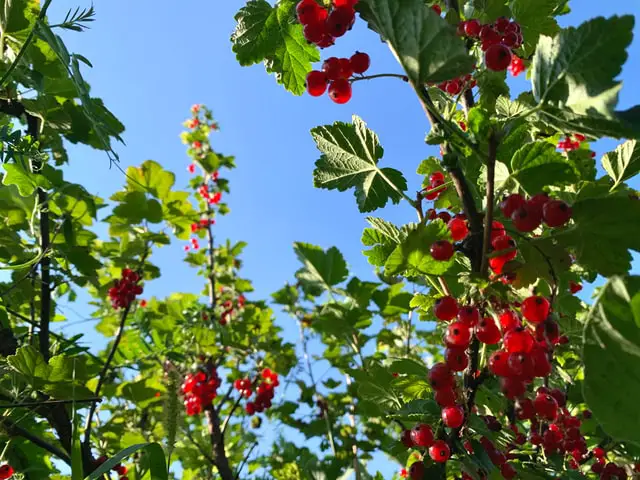Growing Redcurrant bushes is the perfect way to begin as a newcomer to berry gardening. Not only are they easy to care for, but they can also tolerate shade and most types of soil. If you have an area of your garden that has previously failed to grow anything, you can try your redcurrants here and they will likely be successful.

Closely related to blackcurrant bushes, their scientific name is Ribes rubrum and you can forage for redcurrants in wild woodland and hedgerows. They grow very similarly to gooseberries and tolerate low temperatures well. When ready to eat they turn a wonderful glossy red and are round and juicy.
Jump To...
Growing Redcurrant Bushes
Redcurrants are great in jams, wine, sauces, desserts, pies, and cordials. You will achieve sweeter redcurrants by growing your fruit in full sun and you can freeze your berries too.
Redcurrants are one of the earlier fruits to harvest, typically ready anytime from June. Before harvesting, you will be rewarded with small green petalled flowers. Redcurrants can remain productive for twenty plus years once established.
All things considered, there isn’t too much you can do wrong when it comes to growing redcurrants. They are a strong-growing plant that produces a decent yield. As a collective, they are called trusses and should be picked together as so.
Although easy to maintain, you can’t afford to neglect your redcurrant bush. Timings must be accurate for those annual tasks so read our help guide below to ensure you are rewarded with your fruit.
When To Plant Redcurrants
November through to March is a great time to plant your redcurrant bush. Ideally, the roots of your bush should be kept damp prior to being planted.
Where To Plant Redcurrant Bushes
Your redcurrant bush will benefit from a sheltered spot and also away from any frost pockets. They will tolerate shade so you can position yours against a north-facing wall. Preferably though, full sun is best – the crop will be more successful earlier on and sweeter-tasting too.
How To Plant Redcurrant Bushes
Your bush needs well-drained soil and you should aim to plant them 1.5 metres apart and 1.8 metres between rows. You can add some mulch to the base of your bush which will be appreciated.
Growing Redcurrant Bushes in Pots
Generally speaking, you can plant a pot-grown redcurrant bush any time of the year. For best results though, plant in autumn or winter. Your pot should be at least 45cm in diameter and it will need lots of watering during warm spells. You can add some bark or mulch to the top of the soil to help retain moisture.
Redcurrant Supports & Trellises
Currants can be grown as free-standing plants in most instances. However, there are a few options should your bush need some extra support.
- Canes, stakes, and wires. If you tie your main branches onto the wires it can help to achieve a fan shape.
- You can also train your bush against a fence, trellis, or wall.
Redcurrant FAQ’s
Still not completely sure what’s what when it comes to growing, caring for and planting redcurrants? Read our FAQS to help with those last questions you still have.
Redcurrants, along with white and black, are all self-fertile so just the one is required for fruit to be produced successfully.
Redcurrant bushes flower in the spring with small yellow and green flowers.
Harvesting of your redcurrants takes place between the months of June, July, and August. You should aim to harvest your redcurrants in while trusses rather than picking them off individually.
Any pruning you carry out should look at removing any diseased or damaged wood. You want to maintain an open bush with lots of potential for air to circulate. The base should be free of stems to prevent diseases from spreading. When pruning, it’s important to remember that redcurrants bear their fruit on old wood.
